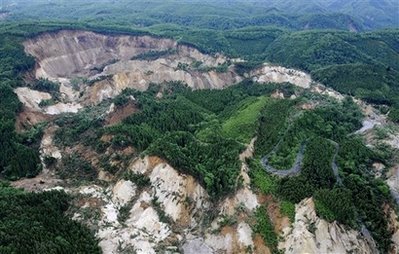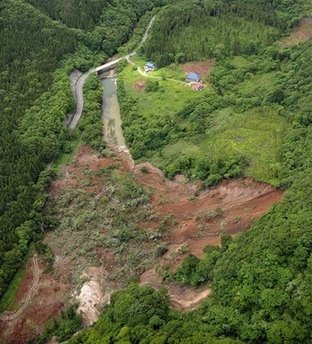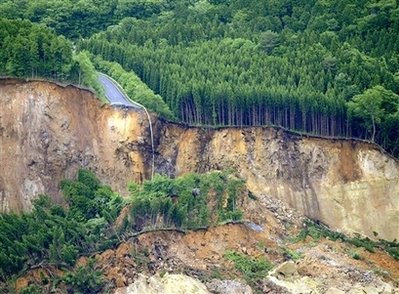16 June 2008
Landslides from the 14th June 2008 “Iwate-Miyagi Inland Earthquake” in Japan
Posted by Dave Petley
At 08:43:46 local time on Saturday 14th June 2008 a magnitude Mw=6.8 (USGS initial estimate) struck eastern Honshu in Japan. Although this earthquake (now being called the Iwate-Miyagi Inland Earthquake) was not particularly large, it occurred at a shallow depth (10 km) below an area that is quite mountainous. This is an areas that is very landslide prone anyway, being subject to active tectonic processes and frequent typhoon rainfall events. Once again, the consequences have been a large number of landslides.
Two days on some pictures are starting to emerge of the impact of the earthquake. The following three AP and Reuters images show quite well some of them:


 The impact of all three on the road network us very clear – reports suggest that this has had a major effect on the rescue and recovery operations, as well as being responsible for a number of fatalities. The landslide in the first image is particularly interesting, but is slightly difficult to understand. Is this a large scale lateral spread?
The impact of all three on the road network us very clear – reports suggest that this has had a major effect on the rescue and recovery operations, as well as being responsible for a number of fatalities. The landslide in the first image is particularly interesting, but is slightly difficult to understand. Is this a large scale lateral spread?
Japan has a remarkable concentration of landslide specialists, so they are well-equipped to deal with this type of problem. Professor Sassa of the International Consortium on Landslides has commented on a large landslide at Aratozawa Dam in Kurihara, Miyagi Prefecture:
“Kyoji Sassa, head of the International Consortium on Landslides, said the volume of collapsed earth near the dam is believed to be more than 10 million cubic meters. Sassa believes that this is comparable to the largest landslides that occurred as a result of the 2004 Niigata Prefecture Chuetsu Earthquake, which also struck in a mountainous region, and to the volume that fell in single landslides after last month’s cataclysmic earthquake in China’s Sichuan Province. “It may have been a ‘deep landslide,’ in which a large amount of earth completely collapses from a point deep in the mountain slope,” Sassa said of the landslide set off by Saturday’s quake.”
Meanwhile, the Daily Yomuri reports that:
“Eleven dams created by landslides that occurred when Saturday’s Iwate-Miyagi Inland Earthquake hit are threatening to collapse, seriously affecting rescue efforts downstream. In response, the Construction and Transport Ministry on Sunday dispatched sediment control experts to the area to conduct a full-scale study on the possible danger posed by the so-called quake lakes building up behind such natural dams. According to the ministry, two quake dams have been confirmed on the Sanhasamagawa river and the Nihasamagawa river, five on the Hasamagawa river in Kurihara, Miyagi Prefecture, and four on the Iwaigawa river in Ichinoseki, Iwate Prefecture. Most of them stretch about 100 to 200 meters wide. Those rivers are feeders of the Kitakamigawa river. Once the water level rises and water spills out from a quake lake, its banks and the natural dam instantly collapse and a wave of mud could sweep into lowlands located downstream. “The danger of a collapse [of quake dams] changes all the time due to rain and aftershocks,” a Construction and Transport Ministry official said. “We have to be very careful.” The official said that the ministry plans to drain water from the quake lakes using heavy machinery to prevent a secondary disaster. There are some houses downstream of quake lakes on the Iwaigawa river. “Because we’ve got information that the water level is gradually rising, we may have to tell residents to evacuate depending on circumstances,” an Ichinoseki municipal government official said.
They have rather a nice image of one of the sites. This is clearly not on the scale of Tangjiashan, but potentially hazardous nonetheless:



 Dave Petley is the Vice-Chancellor of the University of Hull in the United Kingdom. His blog provides commentary and analysis of landslide events occurring worldwide, including the landslides themselves, latest research, and conferences and meetings.
Dave Petley is the Vice-Chancellor of the University of Hull in the United Kingdom. His blog provides commentary and analysis of landslide events occurring worldwide, including the landslides themselves, latest research, and conferences and meetings.